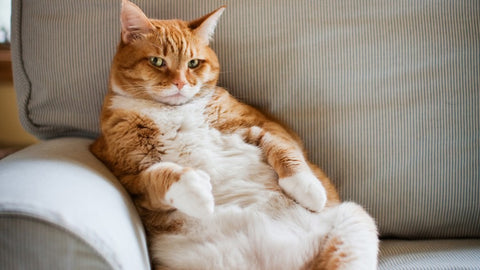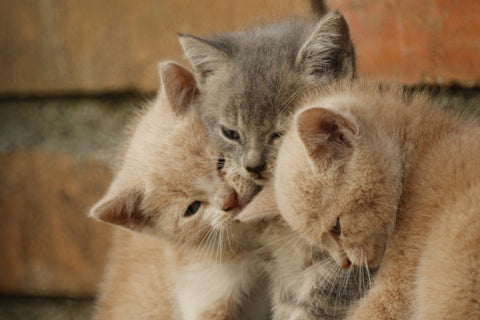
In the last few months, the world has dealt with changes brought about by COVID-19. Seemingly overnight the world slowed as we stayed indoors and readjusted our daily lives to wait out this deadly virus. In doing so, we have reconnected with our loved ones we share our space with, our cats! And now that we are with each other 24/7 we may see some cat behavior problems that we may not understand.
As we take this time and spend it together we are engaging and understanding our cats in a more meaningful way. The rat race having slowed has provided us with the time to better observe their daily routines and leaves us with questions, especially when it comes to our cats. Understanding cat behavior or working though cat behavior problems are centered around a very common theme in all the relationships in our lives, communication, and listening.
There are a lot of great ways to better know your cat. You can dive into the DNA and health markers of your cat with cutting edge technology like that used at Basepaws Cat DNA.
While sometimes you may want to murder your cat, due to troublesome cat’s behavior problems, one of the most key aspects of understanding cat behavior problems, is listening to what your cat is communicating through their actions. What is that specific cat behavior is trying to tell you? Because the truth is most cat behavior problems are readily explained through the action that is perceived as a problem. When we shift our thinking from “bad cat behavior” to a message of communication, we can start to better understand our cat and we can better explain the behavior, or what was previously thought to be “bad cat behavior.

Interpreting Cat Behavior Problems
So what is the key to better understanding our cat? It is all about fundamentally understanding the cat’s behavior from their perspective level mentally and some times even physically. To experience the world through their eyes. When we are tackle cat behavior “problems” from their perspective we can better understand the message that is trying to be communicated. Our cats go from a locked diary to an open book for us to read. And each problematic-behavior cats display becomes a message for us to interpret.
Cats use several methods to communicate. This includes vocalizations, interactions, and physical messaging. Physical messaging includes things like marking, guarding, and aggressive behaviors. When our cat is communicating in this manner, they are indicating they have something to say about that space, place or something that has happened to disrupt their normal routine and rhythms. Most of the time, these types of communication are based on resource concerns, dislikes, needs, or scarcities.
What do cats consider resources? On the most basic level resources generally include food, litter boxes, and lounging spaces. For many cats, it may also include toys, grooming, and attention. When there is a perceived shortage of any one or more of these resources, we may begin to see behavior problems, but what I would tell you from the perspective of Veterinary Technician and Cat Coach with Coach My Cat, is that your cat is telling you exactly what they need to fix the perceived problem for them and what they need. When we take a closer look at the behavior we can get their message, make the needed adjustments to their environment, and stop “bad” cat behavior problems” through fulfilling the natural environmental and emotional needs of our cats.
Fulfilling Your Cat’s Needs
When we explore deeper these environmental and emotional needs we are discussing the aspects of their environment that provide the needs, their most basic and instinctual needs as cats. These include:
- Safe lounging spaces; generally elevated, but some prefer small hidden areas
- Natural feeding patterns of 6-8 small frequent meals throughout the day
- Hunting and prey drive fulfillment, ideally associated with eating
- Litter boxes that work for their needs AND ours equally
- Play, play, play, and more play
Fortunately for cats, the consumer market is catching up with cat’s basic needs and people’s aesthetic desires and attempting to fill the needs of both. Safe products that engage cats are affordable, and generally aesthetically pleasing for owners. This is not quite as easy as it seems and I still regularly encounter clients who are not meeting the needs of their pets, generally inadvertently, and most commonly because they are trying to meet the, “oh you would never know you had a cat” standard of aesthetics, and most importantly scent within the home.
Unfortunately for cats, these things do not always align with a happy mental and emotional state within their environment. So let’s take a look at the most common mistakes made in association with the basic needs of cats and how we can best ensure we provide the basic needs while not allowing them to, necessarily, take over our house.
Provide a Safe Space

When we talk about safe spaces, we generally mean elevated, but that might not be for your cat. Each cat is different, and you need to read your cat’s messages to determine their space. Where does your cat hang out now? Do they climb on counters, shelves, and refrigerators; or do they burrow behind, under, and inside things? Do they climb up on the couch, chairs, and beds seemingly taking the middle-ground? Wherever they are is where they want to be. This is why most cat trees offer multi-levels of lounging options for cats to choose from. Additionally, we want to offer several of the options they prefer based on each cat in our house, and ensure we have enough space of preference for each cat.
When we have a lack of spaces of preference for our cats we may see territorial behaviors, generalized stress, and fighting in multi-cat households. I have even had clients whose cats scratch walls, doors, and furniture in spaces where they are not happy with the lounging options, or there are not enough options and they need to communicate their frustrations.
Understanding Natural Cat Behaviors
Another very important aspect of understanding cat behavior and unraveling perceived cat behavior problems is understanding cats’ natural patterns, and most especially, their eating patterns. Cat’s in the wild will eat several small meals a day, in fact, several studies show as many as 9 times a day. So what does this mean for our indoor feline family? Well, it means that filling a bowl of food 2 times a day and walking away does nothing to satisfy their natural feeding patterns.
If we have been feeding domestic cats this way for forever now, why does it really matter? Well, first because when you know better, you do better. And now that we know better about cats’ natural feeding patterns and cycles, and there are products and means to help meet these needs, we can do better by our cat by doing so. Additionally, we now know that many of the behaviors we consider to be problems are a direct result of unsatisfied hunting and prey-driven need fulfillment. Therefore when we are considering how to work out what we feel are behavioral problems such as cat aggression, we can view the problem as resource concerns and unfulfilled instinctual needs.
So, whether you try using food eggs, feeder mice, hiding catnip toys, or creating treat toys from toilet paper rolls, there is a way to ensure your cats hunting and feeding instincts are linked and this is satisfied multiple times a day.
Potty Talk
Alright, most blogs don’t dive into the litter box. Figuratively or literally, but this one does. The main reason for this is because this is another area where we see families severely disrupted when things are not going well. When cats are not happy with their litter box, they don’t use it. When cats don’t use their box a litany of issues arise in the household. From generalized sanitary concerns to cats getting surrendered to shelters or worse, euthanized, inappropriate elimination is a major basis for client cat behavior problem complaints. But, like anything else, we want to first see this from our cat’s perspective and then correct the issues. The most common litter box issues I encounter are:
- Not enough boxes- aim for 1 per cat + 1
- Placing Litter boxes in a frequently visited space- aim for a non-family oriented space
- Litter Boxes that are too small
- Dirty litter boxes- must clean daily
- Covered litter boxes
- Tucking litter boxes next to a washer, dryer, shower or other “scary” places
Did Someone Say Play?
Cats need to play...a lot. It is part of meeting their hunter instincts and needs. Often I find when cat owners are not exactly in line with how cats play, so I find it a good area to cover when dealing with clients who are concerned about their cat’s behavior or have a behavioral concern. Check out my favorite video by Jackson Galaxy discussing how we play with our cats! Fix Playtime With Your Cat

Basically, you need to play like prey! Short bursts, get your cat going then chill. Think about a mouse or bird they catch. They will play with it, then just kinda hang out. Hold it, maybe let it go, and then start all over again, and then eventually, eat it. Keep this in mind with your cat when you play with them. And remember to find out if your cat is more ground prey or air prey oriented.
Understanding Cat Behavior Problems In The Long Run
Overall, it is important to understand YOUR cat. Know their communication patterns and listen through their perspective and you will much more readily understand what your cat is saying. When you listen to your cat, and you hear their message, not only do you understand cat behavior but you avoid cat problems that might interfere with the human-animal bond between you and your cat, and since we know this bond is the most special and important aspect of our relationship with our cats, we use every method possible to support and enhance this bond through understanding, communication, and LOVE.



